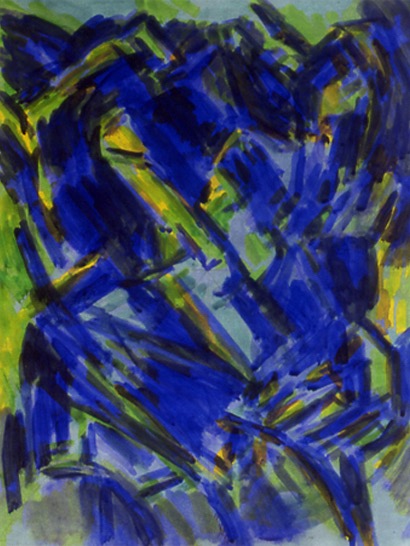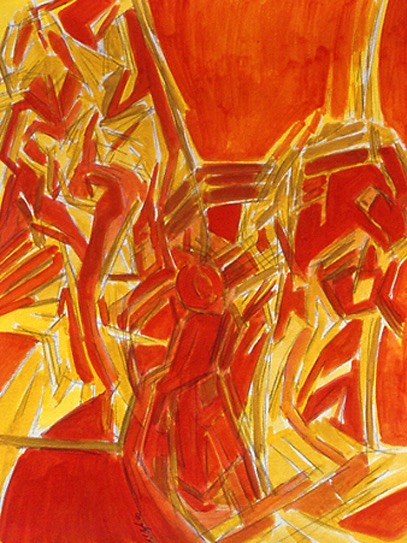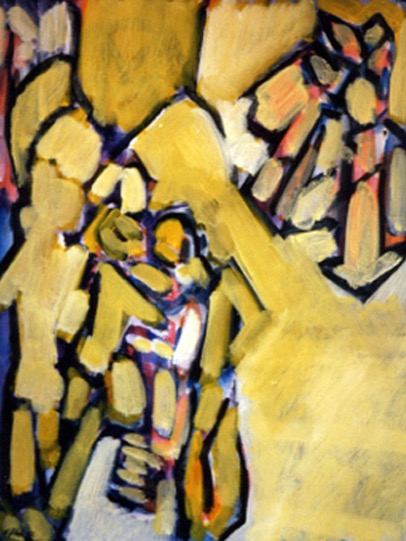Shinjo Matsuri







Background
On several occasions between 1987 and 1991 I travelled to Northern Japan. During these visits I studied the history and traditions of specific local festivals, known in Japanese as matsuri. I viewed several matsuri within the Tohoku region but gave specific attention to one festival called Shinjo Matsuri which had its origins in 1756. There are many strands within this matsuri so I decided to document these multiple threads with drawings, paintings and photographs. I found this festival and its preparation rich in colour, saturated with symbolism and full of energy. My vivid experiences of Japan during these times enriched and informed the core of this research.
There are various forms of music and dance within Shinjo Matsuri including a performance entitled Shishi-Odori (Deer Dance). I thought this dance in particular had a hypnotic and transcendent mood. It is performed within the confines of the local shrines. The main event to this matsuri is a series of parades of floats (yatai). These floats are carefully constructed and designed by teams of local residents of Shinjo. Each team represents a specific area within the city. The themes of the floats are varied and may depict kabuki stories or mythological tales from the distant past. These floats are pulled through the streets by groups of young people with every float having its own musicians, traditionally the instruments are drums, flutes and cymbals. I felt the evening parade is the most mysterious and moving to observe. The floats are peopled with life-size dolls (ningyo) set amongst landscapes or fantastical creatures. These floats gently sway from the movement of the procession and the depicted scenes appear to come to life amid the nightfall of the summer evening’s heat. It is then that reality and fantasy appear to fuse while past, present and future time seem to merge.
My research concluded with a touring exhibition and lecture series entitled ‘Celebrating Japan’. This project had sponsors, which included The Great Britain Sasakawa Foundation, Fuji Film Professional, ‘Japan Festival 1991’ and Quay Arts Centre. These studies were also supported by the generosity of family and friends.
Nigel Caple
2021

Extract from the exhibition catalogue ‘Celebrating Japan’ paintings by Nigel Caple.
In looking at the photographs of, and paintings inspired by this festival or matsuri from Northern Japan, I am reminded of the titles of books by a leading psychoanalyst, Joyce McDougall. ‘Theatres of the Mind’ (published 1986) and the other ‘Theatres of the Body’ (published 1989). Such titles suggested to me very closely the type of imagery used in Shinjo Maturi’s Yatai parade.
Since psychoanalysts do talk of the psyche as being a kind of container, housing images of people, things, monsters, animals, villains, I do feel they provide a wonderful picture of the complexity of our psyches.
As Nigel says, Shinjo’s festival floats are built by local people for the whole community to share and they are based upon Japanese mythology. By contrast western culture has relegated its myths to become fairy tales whereas in Japan it seems that the fairy tales or myths are brought into the adult culture. I thought too that there is here also a connection with Winnicott’s ideas about the enormous importance of imaginative playing, the need for a time in which imagination can flow freely and blossom. Thus once a year this community is taking time out of the everyday and creating a setting for this shared imaginative activity.
Clearly this festival provides a fascinating choice of subject matter for a painter, but I wonder what are the pictorial equivalents for these events? How is the impact of this astonishing spectacle worked into a two dimensional symbol? For instance, music plays an important part in these happenings, so I like to think about these activities of the farmers who, Nigel says, play their instruments with a strong sense of the spirit of the festival rather than perfecting their techniques. Also, there are the antelope dancers who beat drums, which are hidden under their costumes, like hearts beating. Rhythm is obviously essential both in music and painting; the rhythm in Nigel’s paintings is especially clear, I think, in two of them, ‘The fish and the people’ and ‘The boy and the fish’. These show a visual rhythmic beat within their design, which could even, have grown out of the drum beat rhythms of the festival.
It is really the viewer who now has to make the connection with the paintings. Having seen the sort of leap Nigel Caple has made in his response through paint to this festival, it is now up to the spectators to make their own leap which will take them away from literal representation or even recognisable themes, and give an enriched experience which is entirely their own.
Marion Milner
1991


